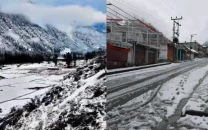Making of the Charaghan Bazaar
Mohmand’s most vibrant nightlife centre would’ve remained a desolate piece of land had one man not swum upstream

Life for a lot many living in Khyber Pakhtunkhwa’s tribal districts changed for the worse under years of militancy.
Employment was scarce, fear reigned the narrow streets and the 2011 shooting incident which claimed lives of several truckers became the straw that broke the camel’s back. Afghan trade, which had long served as a means of income generation for the district, could no longer be envisioned. By 2013, when insurgency was at its peak in the region, the lure of safety and economic stability had started driving most locals to big cities like Lahore, Karachi, Islamabad and Peshawar.
One local however, was adamant on staying back against all odds. For Ijaz Ahmad from Mohmand district, migration at the time, although popular with many, did not seem like a viable option. “Things were bad here, but I wasn’t educated so as a blue-collar worker my prospects were still limited be it here or there. Most of my people left for Peshawar, where they started selling boiled corn out of a pushcart outside schools and colleges. I too initially tried working as a daily-wage earner, but returned in 2013 when everyone was fleeing,” told Ahmad, who belongs to the Halimzai clan.
With a few thousand rupees to his name and a stretch of bootless land near the PakAfghan border, lent to Ahmad by his uncle, he decided to take the risk of setting up a small shop. “Starting out, I just thought that this would at least be better than lugging a pushcart under the scorching sun, in Peshawar or Lahore or whichever city I’d migrate to,” he recalled. At the time, Ijaz Ahmad Halimzai’s Hattii, as it’s locally called, was the first in the area. As his business grew with the passage of time, it started attracting other businesses to the locale too.
Also read The price she paid was death
Soon, it was a thriving little business hub in the middle of what was once an ineffective patch of land by the Durand Line. “There was no marketplace in the area and truckers associated with marble transport and miners working in the region had to go to other areas looking for bazaars. When the first set of businesses started opening stores here, this unknown land suddenly became a centre of attention for a lot many people, leading this budding market to see exponential growth,” the businessman said. As the market flourished from a handful of stores to a thriving network of businesses, it was formally baptised as Charaghan Bazaar.
Which, according to Ahmad, is a well thought-out metaphorical reference to the market’s significance in the area. “Charghan means light in local tongue, and Charagahan Bazaar is a beacon of light and hope for the people, in the middle of this poverty stricken district,” he opined. Taking inspiration from its name, Charaghan Bazaar over the last few years has emerged as one of the most vibrant nightlife centres in the entire district, featuring a variety of stores ranging from diners and cafes to those selling milk and butter. Ahmad’s shop in particular, which started out as a few thousand rupees of investment not too long ago, has now grown into the area’s biggest convenience store.
“The growth of my business along with many other businesses here, was fueled by the initiation of mining works in the mountains. Whenever mine owners needed anything from milk and bread to cold drinks, cooking oil or safety-razors, my store was the nearest one,” Ahmad told this correspondent. According to Muhammad Khan, an area local, Charaghan Bazaar today is nothing short of a miracle for the people here. “Five years ago, when everyone was fleeing, no one could even imagine a street with such lively nightlife in tehsil Halimzai.
Now there’s a petrol pump here, along with mechanic shops and even a vibrant food street, where you can find anything ranging from pizzas to mutton karahis till wee hours of the night and even have homedelivery. Just like the big cities,” he told The Express Tribune.

















COMMENTS
Comments are moderated and generally will be posted if they are on-topic and not abusive.
For more information, please see our Comments FAQ